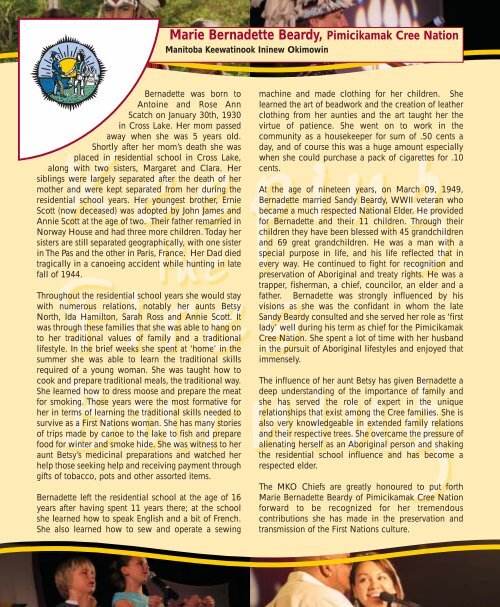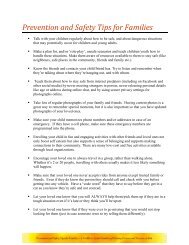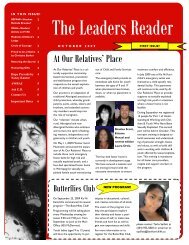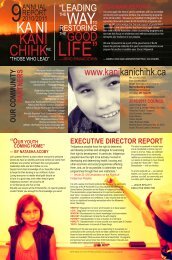Purpose Statements - Ka Ni Kanichihk
Purpose Statements - Ka Ni Kanichihk
Purpose Statements - Ka Ni Kanichihk
You also want an ePaper? Increase the reach of your titles
YUMPU automatically turns print PDFs into web optimized ePapers that Google loves.
Marie Bernadette Beardy, Pimicikamak Cree NationManitoba Keewatinook Ininew OkimowinBernadette was born toAntoine and Rose AnnScatch on January 30th, 1930in Cross Lake. Her mom passedaway when she was 5 years old.Shortly after her mom’s death she wasplaced in residential school in Cross Lake,along with two sisters, Margaret and Clara. Hersiblings were largely separated after the death of hermother and were kept separated from her during theresidential school years. Her youngest brother, ErnieScott (now deceased) was adopted by John James andAnnie Scott at the age of two. Their father remarried inNorway House and had three more children. Today hersisters are still separated geographically, with one sisterin The Pas and the other in Paris, France. Her Dad diedtragically in a canoeing accident while hunting in latefall of 1944.Throughout the residential school years she would staywith numerous relations, notably her aunts BetsyNorth, Ida Hamilton, Sarah Ross and Annie Scott. Itwas through these families that she was able to hang onto her traditional values of family and a traditionallifestyle. In the brief weeks she spent at ‘home’ in thesummer she was able to learn the traditional skillsrequired of a young woman. She was taught how tocook and prepare traditional meals, the traditional way.She learned how to dress moose and prepare the meatfor smoking. Those years were the most formative forher in terms of learning the traditional skills needed tosurvive as a First Nations woman. She has many storiesof trips made by canoe to the lake to fish and preparefood for winter and smoke hide. She was witness to heraunt Betsy’s medicinal preparations and watched herhelp those seeking help and receiving payment throughgifts of tobacco, pots and other assorted items.Bernadette left the residential school at the age of 16years after having spent 11 years there; at the schoolshe learned how to speak English and a bit of French.She also learned how to sew and operate a sewingmachine and made clothing for her children. Shelearned the art of beadwork and the creation of leatherclothing from her aunties and the art taught her thevirtue of patience. She went on to work in thecommunity as a housekeeper for sum of .50 cents aday, and of course this was a huge amount especiallywhen she could purchase a pack of cigarettes for .10cents.At the age of nineteen years, on March 09, 1949,Bernadette married Sandy Beardy, WWII veteran whobecame a much respected National Elder. He providedfor Bernadette and their 11 children. Through theirchildren they have been blessed with 45 grandchildrenand 69 great grandchildren. He was a man with aspecial purpose in life, and his life reflected that inevery way. He continued to fight for recognition andpreservation of Aboriginal and treaty rights. He was atrapper, fisherman, a chief, councilor, an elder and afather. Bernadette was strongly influenced by hisvisions as she was the confidant in whom the lateSandy Beardy consulted and she served her role as ‘firstlady’ well during his term as chief for the PimicikamakCree Nation. She spent a lot of time with her husbandin the pursuit of Aboriginal lifestyles and enjoyed thatimmensely.The influence of her aunt Betsy has given Bernadette adeep understanding of the importance of family andshe has served the role of expert in the uniquerelationships that exist among the Cree families. She isalso very knowledgeable in extended family relationsand their respective trees. She overcame the pressure ofalienating herself as an Aboriginal person and shakingthe residential school influence and has become arespected elder.The MKO Chiefs are greatly honoured to put forthMarie Bernadette Beardy of Pimicikamak Cree Nationforward to be recognized for her tremendouscontributions she has made in the preservation andtransmission of the First Nations culture.






